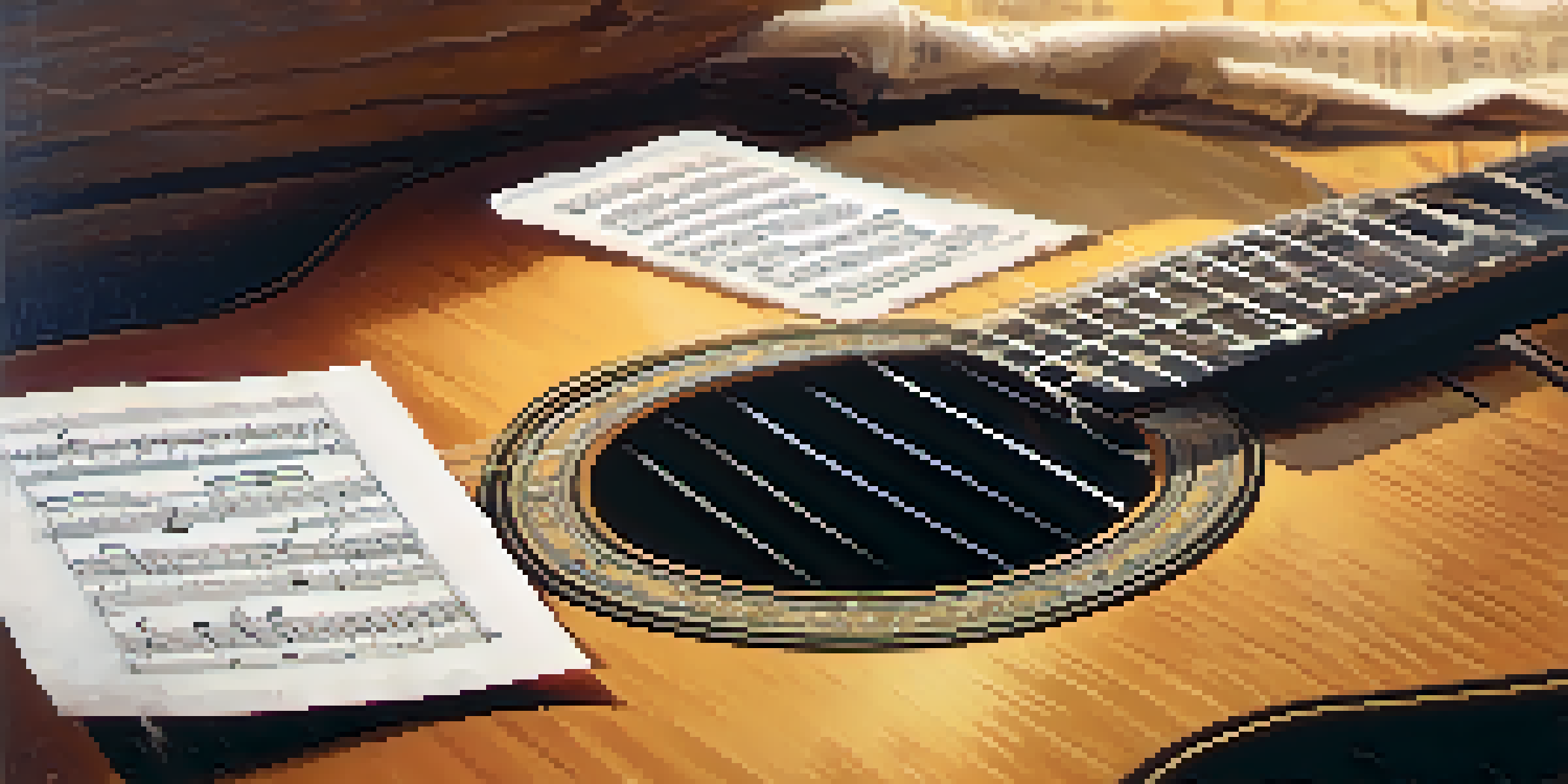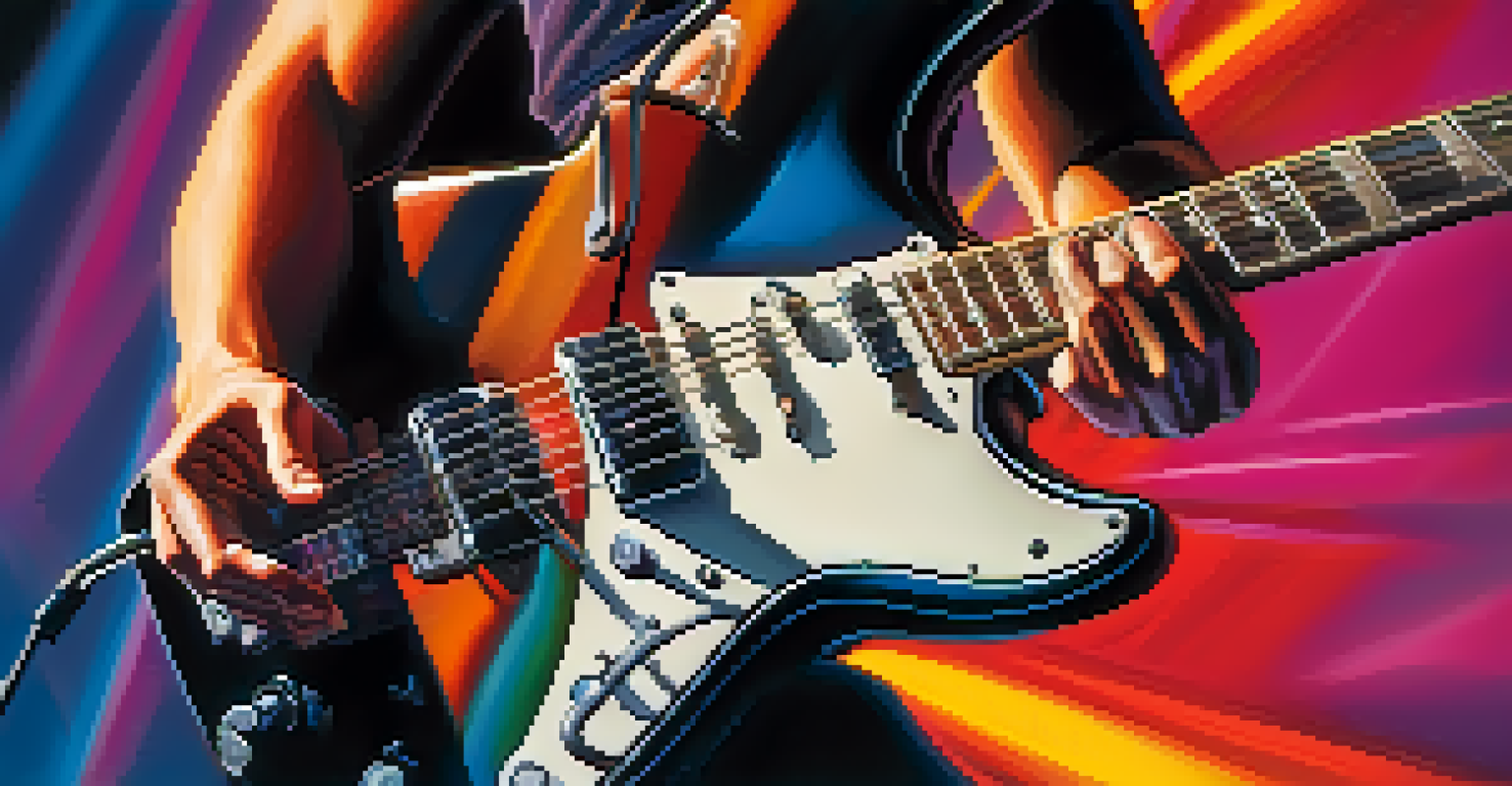The Pentatonic Scale: Essential Patterns for Guitarists

Understanding the Pentatonic Scale and Its Importance
The pentatonic scale, a five-note scale, is one of the most fundamental tools for guitarists. It’s widely used across various genres, from rock to blues and jazz. Understanding this scale opens the door to countless musical possibilities, making it essential for both beginners and seasoned players alike.
The pentatonic scale is the foundation of modern music; without it, we'd be lost in a sea of notes.
One of the reasons the pentatonic scale is so popular is its simplicity. Unlike the seven-note scales, the pentatonic scale omits certain notes that can create dissonance, making it easier to play melodies that sound good. This makes it an ideal choice for improvisation, allowing musicians to express themselves freely without worrying about hitting the wrong notes.
Additionally, many iconic guitar solos and riffs are rooted in the pentatonic scale. Think of famous guitarists like Jimi Hendrix and Eric Clapton; their signature sounds often stem from these five notes. By mastering the pentatonic scale, you’ll be able to play along with countless songs, making it a vital part of your musical toolkit.
The Major and Minor Pentatonic Scales Explained
The pentatonic scale comes in two flavors: major and minor, each offering unique emotional qualities. The major pentatonic scale typically evokes a bright and happy sound, while the minor pentatonic scale has a more bluesy and melancholic feel. Understanding these differences can help you choose the right scale for your musical context.

To construct a major pentatonic scale, start with the root note and include the second, third, fifth, and sixth intervals. For example, the C major pentatonic scale consists of the notes C, D, E, G, and A. On the other hand, the minor pentatonic scale is built using the root note, flat third, fourth, fifth, and flat seventh intervals—like A minor pentatonic with the notes A, C, D, E, and G.
Pentatonic Scale Basics
The pentatonic scale is a five-note scale essential for guitarists, known for its simplicity and wide application across various music genres.
By learning both major and minor pentatonic scales, you can switch between different moods and styles in your playing. Experimenting with these scales can also enhance your songwriting and improvisational skills, allowing you to create more dynamic music.
Common Pentatonic Scale Patterns to Practice
Once you've grasped the basics, it's time to dive into some essential pentatonic scale patterns. One popular pattern is the 'box' shape, which allows you to play the scale across the fretboard easily. By practicing this shape, you can familiarize yourself with the notes and develop muscle memory.
Improvisation is not a skill; it’s a way of expressing your soul through music.
Another effective way to practice is by combining the pentatonic scale with various rhythmic patterns. This approach not only makes practicing more engaging but also helps you develop a unique style. For instance, try playing the scale in triplets or incorporating staccato notes to challenge yourself.
Don’t forget to explore different fingerings and positions on the fretboard as you practice these patterns. This will give you a broader understanding of the scale and help you discover new sounds and techniques. The more you play around with these patterns, the more fluid and confident you'll become.
Incorporating the Pentatonic Scale into Your Playing
Now that you have a solid understanding of pentatonic scale patterns, it’s time to incorporate them into your playing. Start by using these scales in your solos; they are perfect for improvisation. When jamming, you can rely on the pentatonic scale to create catchy melodies that fit seamlessly over chord progressions.
You can also integrate the scale into your rhythm playing. Try using the pentatonic notes as part of your chord voicings or as embellishments in riffs. This adds depth to your playing and keeps things interesting for both you and your listeners.
Major vs. Minor Pentatonic
Understanding the differences between major and minor pentatonic scales allows musicians to evoke distinct emotional qualities in their music.
As you become more comfortable, challenge yourself to create original riffs and solos using the pentatonic scale. This will not only enhance your creativity but also solidify your understanding of the scale. Remember, practice makes perfect, so keep experimenting!
Using the Pentatonic Scale for Improvisation
Improvisation can be intimidating, but the pentatonic scale is your best friend when it comes to easing into it. Because of its simplicity, you can freely explore melodies without the fear of hitting 'wrong' notes. The pentatonic scale provides a safe space where you can express your musical ideas confidently.
To start improvising, choose a backing track in a specific key and apply the corresponding pentatonic scale. As you play, focus on creating melodic phrases that resonate with the music. You might start with short, simple licks and gradually expand your ideas as you gain confidence.
Remember, improvisation is all about experimentation. Don't hesitate to try out new phrases or even combine the pentatonic scale with other scales. The beauty of improvising lies in its spontaneity, so let yourself be free and enjoy the process!
Famous Guitarists Who Mastered the Pentatonic Scale
Many legendary guitarists have embraced the pentatonic scale to create unforgettable music. For example, B.B. King used the minor pentatonic scale to craft his signature blues sound, characterized by expressive bends and soulful phrasing. His mastery of this scale has inspired countless musicians around the world.
Another guitarist known for his use of the pentatonic scale is Jimmy Page of Led Zeppelin. His iconic solos often feature pentatonic patterns that blend seamlessly with the band's heavy sound. By studying his techniques, you can gain insights into how to incorporate the pentatonic scale into your own playing.
Improvisation with Pentatonic Scale
The pentatonic scale serves as a versatile tool for improvisation, enabling musicians to explore melodies confidently and creatively.
Finally, we can't forget about Carlos Santana, who beautifully combines the pentatonic scale with melodic phrasing and passionate playing. His ability to weave these five notes into emotional solos showcases the versatility of the pentatonic scale, proving that it can be a powerful tool in any guitarist's repertoire.
Tips for Mastering the Pentatonic Scale
Mastering the pentatonic scale requires dedication and practice, but there are several tips to help you along the way. First, practice regularly and set specific goals for your practice sessions. This will help you track your progress and stay motivated as you work towards mastering the scale.
Incorporate ear training into your practice routine by listening to songs that feature the pentatonic scale prominently. Try to identify the scale in solos and licks, and challenge yourself to replicate them. This will not only improve your playing but also develop your musical ear.

Lastly, don't be afraid to make mistakes! Embrace the learning process, and remember that every guitarist has been where you are now. With time and persistence, you'll find that the pentatonic scale becomes second nature, opening up a world of musical expression.